Password Protected Circuit Breaker System using Arduino Vol. 24 l Sep-Nov 2020 Our Vision: “To become a center of excellence in the fields of technical education & research and create responsible citizens” 1
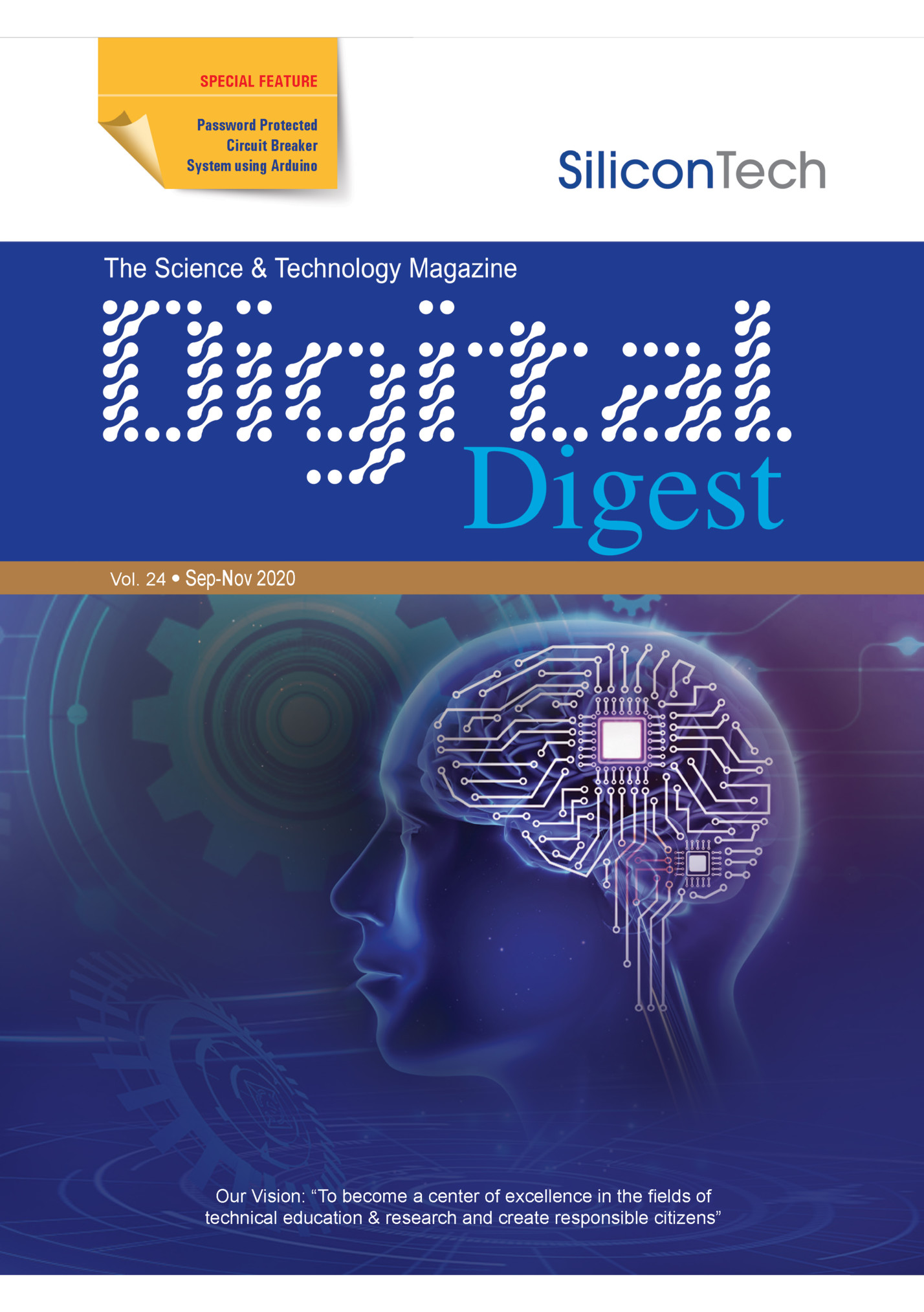
Cognitive Computing Cognitive computing is based on simulation of the human thought process. It uses an amalgamation of different techniques like artificial intelligence, neural networks, machine learning, natural language processing, sentiment analysis and contextual awareness to find a solution to day-to-day problems just like humans. Cognitive computing redefines the class of problems that a computer can solve. applicable at that moment. They are capable of identifying and comprehending contextual syntax, domain, regulations, user’s profile, and objective. Some of these cognitive computing systems use both structured and unstructured data along with sensory inputs like visual, gestural, auditory etc. The unstructured data doesn’t have a predefined data model as is the case with structured data. Computing has evolved a lot since its inception. The first era of computing started with Charles Babbage who introduced the concepts of programmable computer, navigational calculation and invented the mechanical computer. The second era experienced digitally programmable computers and different programming languages. The third era consists of cognitive computing techniques capable of imitating human behavior and reasoning to solve complex problems. There is a subtle difference in the approach of solving problems using AI and cognitive computing. AI tries to solve problems by finding patterns in the data space. It tries to draw conclusions based on these discovered patterns and makes decisions. Cognitive systems don’t make decisions, rather they only supplement decision making. They try to simulate the human thought process to find solutions to complex problems. Cognitive systems provide information for humans to take decisions. Cognitive computing is a subset of artificial intelligence. There are several applications of cognitive computing. Vantage software is one such product that helps investment bankers to analyze huge data and provide suggestions as to where the clients’ funds could be invested. LifeLearn provides a veterinary decision-support tool named Sofie which gives recommendations instantly, enabling busy vets to save time and look after patients with quality consideration. Malware attacks are prevented by using big data and machine learning algorithms. Cognitive Engine has the ability to multiply the value of all the IT investments by a combination of all the data and the processes of an organization, by cognitive intelligence, and suggest steps that hold the highest revenue impact on the company. Cogito is a multilingual cognitive software that provides humans the ability to evaluate and comprehend conversations in different languages. Its core algorithms are based on natural language processing. Cognitive systems are adaptive, dynamic in data gathering, understanding goals, and requirements. These systems are highly interactive and are able to communicate with humans in natural language. Several chatbots have already achieved this ability of communicating with consumers without human intervention. These systems remember previous interactions and provide information that is Cognitive computing provides and improves the computer interaction that impersonates the working of the human brain and thereby helps in better decision-making processes.It provides customized results and deep insights by analysing vast data from different sources. Cognitive computing is an extremely powerful tool which is capable of providing us with excellent solutions and further extending the horizons of computation. Dr. Pamela Chaudhury Dept. of CSE 2
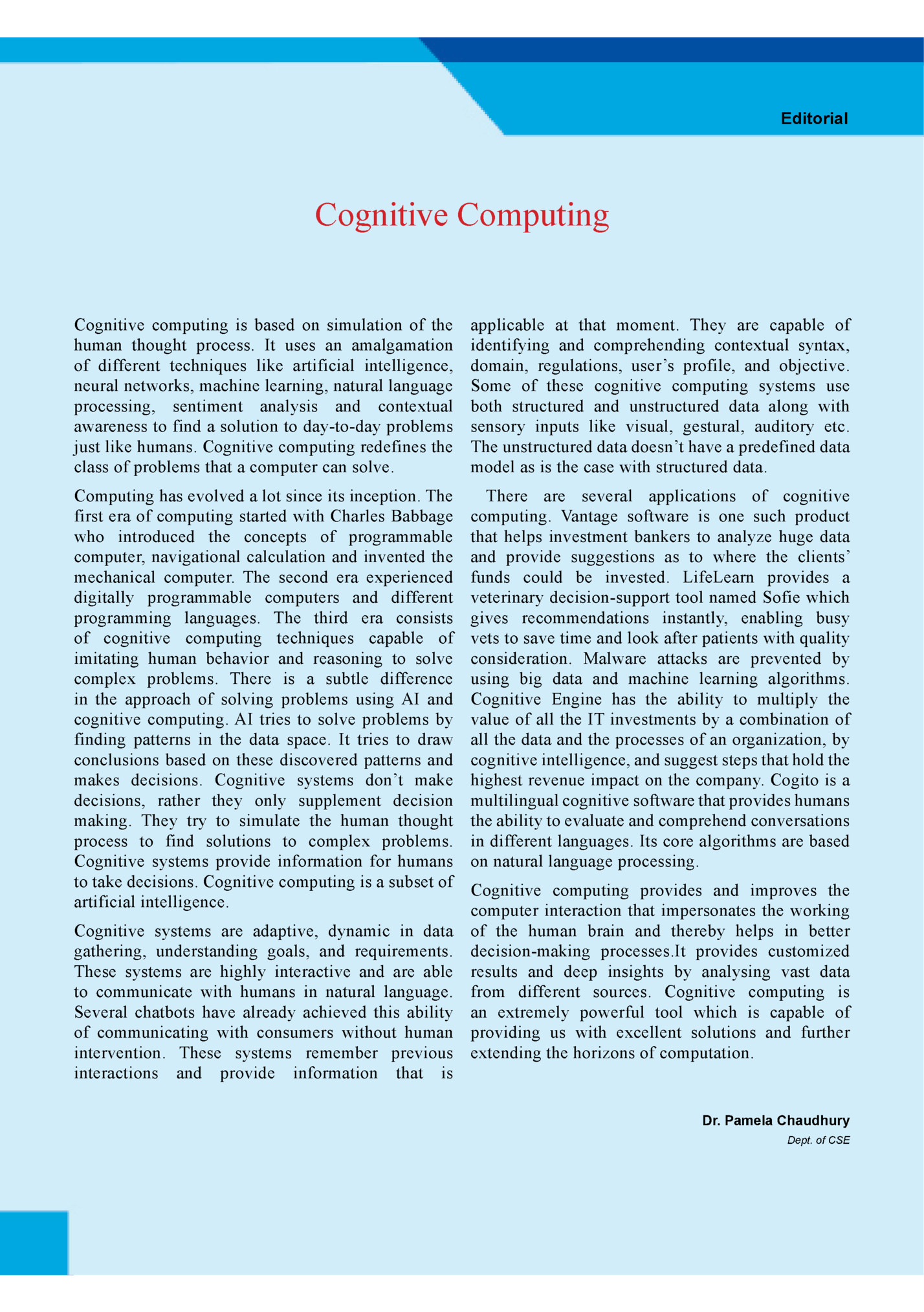
Detecting Diabetic Retinopathy using Deep Learning Abstract : Diabetic Retinopathy is one of the major causes of blindness around the world. This disease affects those people who suffer from diabetes and mainly aged diabetes patients. Many hospitals around the world try their best to conduct research and prevent blindness caused due to diabetic retinopathy. Being able to detect diabetic retinopathy before it is too advanced is a major challenge. This work focuses on detecting whether a patient has reached the stage of diabetic retinopathy or not and if yes, then which stage. The deep learning neural network is used to for this purpose classify the images of eyes of patients. Keywords: Deep learning, neural networks, image classification, medical imaging, diabetic retinopathy, medical imaging analysis, machine learning. I. INTRODUCTION Diabetic retinopathy is the most common form of diabetic eye disease. Diabetic retinopathy usually only affects people who have had diabetes (diagnosed or undiagnosed) for a significant number of years [1]. Retinopathy can affect all diabetics and becomes particularly dangerous, increasing the risk of blindness, if it is left untreated. The risk of developing diabetic retinopathy is known to increase with age as well as with less well controlled blood sugar and blood pressure level. According to the NHS, 1280 new cases of blindness caused by diabetic retinopathy are reported each year in England alone, while a further 4,200 people in the country are thought to be at risk of retinopathy-related vision loss [2]. Diabetic retinopathy occurs when changes in blood glucose levels change the retinal blood vessels. In some cases, these vessels will swell up (macular oedema) and leak fluid into the rear of the eye. Diabetic retinopathy can gradually become more serious and progress from background retinopathy to seriously affecting vision and can lead to blindness. Like many conditions of this nature, the early stages of diabetic retinopathy may occur without symptoms and without pain. An actual influence on the vision will not occur until the disease advances. Symptoms of retinopathy to look out for include: Sudden changes in vision / blurred vision, Eye floaters and spots, Double vision, Eye pain As, diabetic retinopathy is a leading cause of blindness among working-age adults, early detection of this condition is critical for good prognosis. Many adults who are suffering from diabetes have a high probability of being diagnosed with diabetic retinopathy at some stage of their life. In general, diabetic retinopathy is curable if detected at the early stages. But if the patient is diagnosed at a very severe stage, then it may not be curable at all [3]. This work focuses on detecting whether a person suffering from diabetes has diabetic retinopathy or not. The power of deep neural networks from the field of deep learning is employed for this purpose. In specific, the CNN (Convolutional Neural Network) architecture is used. A large set of retina images were taken using fundus photography under a variety of imaging conditions. Fundus photography involves photographing the rear of an eye; also known as the fundus [4]. Specialized fundus cameras consisting of an intricate microscope attached to a flash enabled camera are used in fundus photography. The main structures that can be visualized in a fundus photo are the central and peripheral retina, optic discand macula [5]. Fundus photography can be performed with colored filters, or with specialized dyes including fluorescein and indocyanine green. An example of how the images look like is given in fig.1 Figure 1. A retina image taken using fundus Photography 3

images, different learning algorithms, and different neural network architectures and compare which combination gives the best results for detection of diabetic retinopathy. Using the current traditional cures and remedies the medical system is taking much time than needed to know about Diabetic retinopathy. We proposed a system in which the model can be trained using deep neural network on varieties of retina images and then by validating on the images weget better results can be otained. This takes less time than the usual traditional detection methodologies. II. DATA COLLECTION The data set is collected from the Kaggle website [6]. The dataset contains retina scan images taken using fundus photography under a variety of imaging conditions. The dataset contains 3,662 images for training 1,928 images for testing. The default images provided on the website are colored images. They are very high-resolution images some ranging to around 4k dimensionality. Train directory contains all the images of retina that we train and validate the neural network model on. Train CSV file contains the labels corresponding to the images in the train directory. Similar is the structure for the test data as well. But the test CSV file does not contain the labels III. APPROACH In this work, the severity of diabolic retinopathy is classified by the use of neural networks. The classification is done by ResNet34 [4]. This model as shown in fig 3contains 34 CNN layers. The first layer uses 7*7 filter and the next layers use 3*3. It uses Global average pooling layer and a 5-way fully-connected layer with Softmax in the end. ResNet34 solves the degradation problem i.e. the accuracy gets saturated and degrades rapidly on the increase in networkdepth. The dataset has been divided into a train directory, test directory, train.csv file, and test.csv file. The data is divided into five classes based on the severity of diabetic retinopathy. The following are the five classes: 0- No DR 1- Mild 2- Moderate 3- Severe 4- Proliferative DR The numbering is done based on increasing severity where 0 means no diabetic retinopathy and 4 means the highest stage, that is, proliferative diabetic retinopathy. In the dataset, 1,805 images with no diabetic retinopathy, 370 images with mild, 999 images with moderate, 193 images with severe and 295 images with proliferative diabetic retinopathy were present. The number of images consider per class ratio is shown in fig. 2. Figure 2. Number of Images per Class 4 Figure 3. ResNet34 blocks
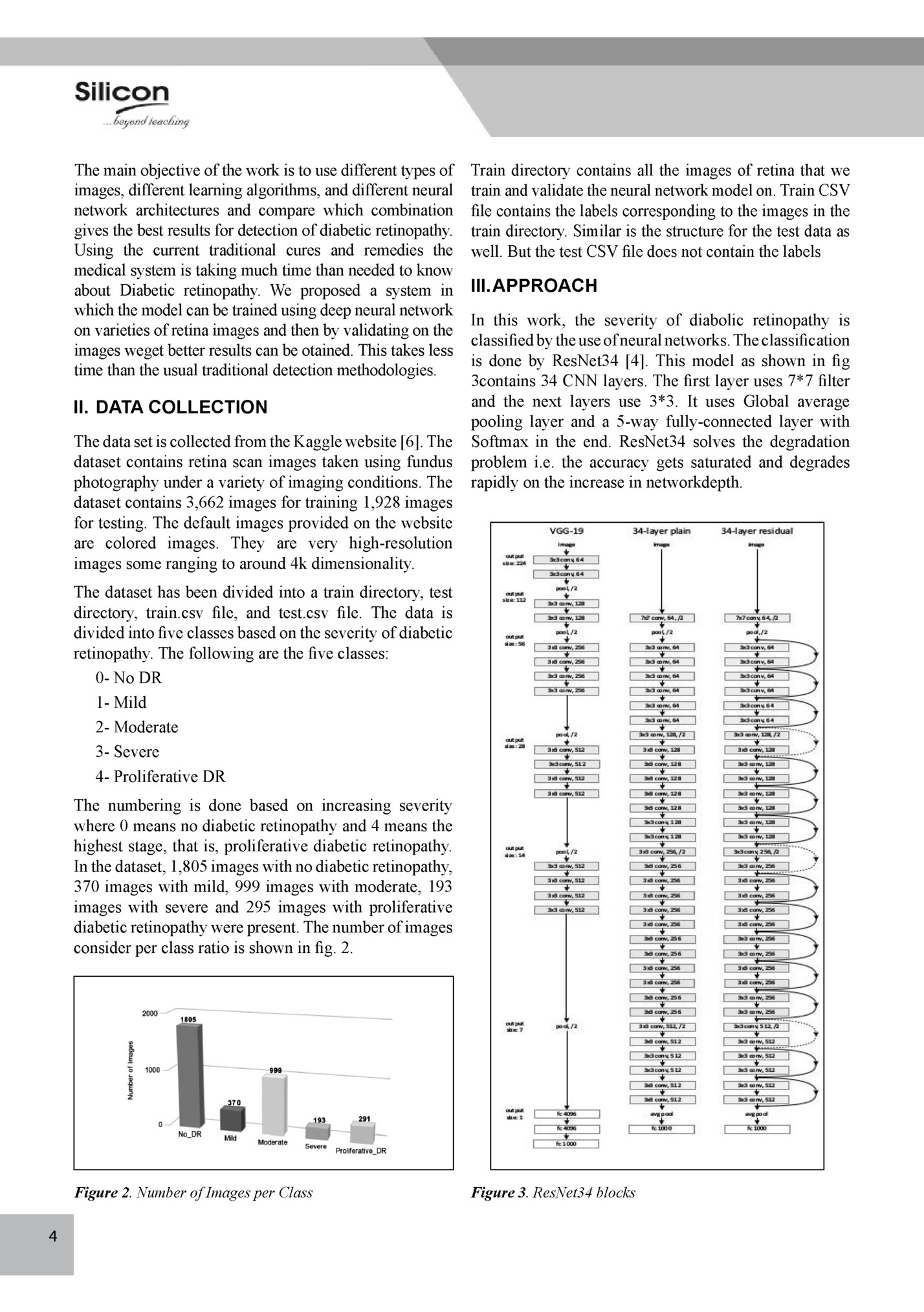
For the first stage of the experimentation the ResNet34 is trained for 20 epochs and for 3 epochs after finding the optimal learning rate of the neural network. This process is repeated for all the three different colored datasets (colored, grayscale, andgaussian). C. Gaussian Filtered Images Results For grayscale images, the lowest error rate after 20 epochs of training is 0.221311 with best training loss of 0.478799 and best validation loss of 0.578836 as shown in figure 6. A. Colored Images Results During the initial training of colored images, for the first 20 epochs the best error rate is 0.195355. After learning rate optimization the best error rate of 0.178962 is achieved. The lowest training loss is 0.441782 and validation loss is 0.541847 as shown in figure 4. Figure 6. Gaussian Filtered Images Training Loss After 20 Epochs Figure 4. Colored Images Traning Loss after 20 Epochs B. Grayscale Images Results For grayscale images, the lowest error rate after 20 epochs of training is 0.196721 with best training loss of 0.480602 and best validation loss of 0.520497 as shown in figure 5. D. Training Result Tables The following tables show the results of training on colored, grayscale, and gaussian filtered retina images. We have trained each of the image sets for 20 epochs. In the following tables 1,2 and 3the results of the last three epochs are shown epoch 18 19 20 train_loss 0.456303 0.483539 0.441782 valid_loss 0.551894 0.548007 0.541847 error_rate 0.207650 0.214481 0.211749 Table 1. Last three epoch results for colored retina images epoch 18 19 20 train_loss 0.492623 0.512907 0.480602 valid_loss 0.516096 0.520497 0.521209 error_rate 0.200820 0.200820 0.196721 Table 2. Last three epoch results for grayscale retina images epoch 17 18 19 Figure 5. Grayscale Images Training Loss After 20 Epochs train_loss 0.519309 0.510745 0.478799 valid_loss 0.587234 0.579334 0.578836 error_rate 0.229508 0.224044 0.221311 Table 3. Last three epoch results for Gaussian filtered retina images 5
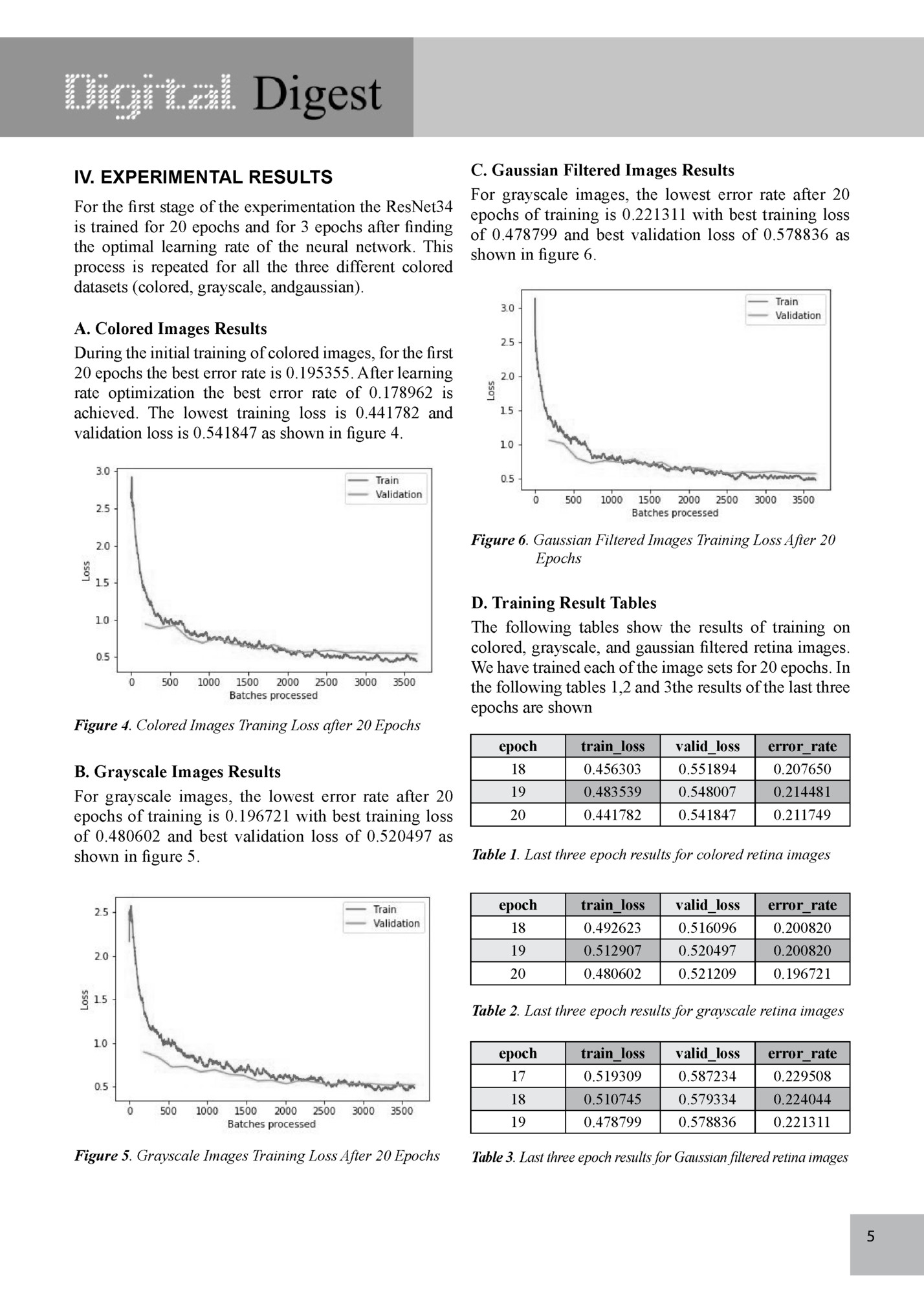
training loss after 20 epochs is the least for colored retina images (Table 1). For the error rate, the least error rate in the case of training grayscale images is obtained. But the training loss is more in case of grayscale images than in colored images. The neural network seems to be performing the worst in the case of gaussian filtered images when taking the error rate as a result metric. Also, the validation loss is the highest in this case. The results show that perhaps, training a bigger neural network model on a mixture of all images may provide much better results. E. Validation Results The validation results provide a good insight of how good/bad the neural network model is performing while validating on the dataset. Figures 7, 8, and 9 shows the confusion matrix interpolation plot Figure 8. Confusion Matrix for Grayscale Images Validation for the validation of the retina images. The figures correspond to colored images validation, grayscale images validation, and gaussian filtered images validation results respectively.It may be clearly observe that in all cases, the ResNet34 neural network model is perfectly classifying the No_DRclass. This is because, this class has the most number of images (almost 1800 images) and it is getting enough images for that class to learn the patterns. Whereas, for the other classes, the number images are quite less, and below 1000 images per class as well. Figure 9. Confusion Matrix for Gaussian Filtered Images Validation Figure 7. Confusion Matrix for Colored Images Validation 6 The validation mistakes in some cases are quite profound as well. For example, in the case of colored retina images validation, the neural network model is classifying 18 Moderate class as Proliferate_ DRclass. And in total, it is misclassifying 131 images out of 732 validation images. In the case of grayscale validation images, the neural network model is misclassifying 143 images out of 732 validation images.Here, validation results are worse than the colored images validation results. In the case of gaussian filtered validation images, the neural network model is misclassifying 146 images out of 732 validation images. The validation results

gaussian filtering to the retina images, they are losing many of the pixel and color features. Therefore, the neural network model is finding it difficult to learn all the important features. F. Results from the Larger Dataset This dataset contains 35,126 images and is 35 gigabytes in size. For this specific dataset, we trained two different neural networkmodels: ResNet34, ResNet50. We are showing the best set of results that were obtained by training the ResNet50 model. The SGD optimizer is used with image augmentation and learning rate scheduler for hyperparameter tuning. V. CONCLUSIONS: The presented methods using deep learning and neural networks on the retina images achieves 78% validation accuracy. This is 3% higher than manual method of detection. Although the increase in accuracy is not too much but it can be further improved using larger neural networks for training and using more robust image processing techniques. Also, using larger images for training the neural network may help capture and extract more useful features. ACKNOWLEDGMENT We express our sincere gratitude to our project guideDr. Ramakrushna Swain of CSE department for his guidance in carrying out this projectwork. VI. REFERENCES: [1] Goodfellow et al., “Convolutional Networks”, in Deep Learning, pp. 326 - 366. [2] Panwar et al., “Fundus Photography in the 21st Century—A Review of Recent Technological Advances and Their Implications for Worldwide Healthcare”. Telemedicine and e-Health, March 2016. Figure 10. Accuracy plot for ResNet50 trained for 40 epochs with SGD optimizer and with data augmentation [3] Mingyuan Xin and Yong Wang. “Research on image classification model based on deep convolution neural network”.EURASIP Journal on Image Processing. [4] JaakkoSahlsten, Joel Jaskari, JyriKivinen, Lauri Turunen, Esajanio, KustaaHietala, Kimmo Kaski, “Deep Learning Fundus Image Analysis for Diabetic Retinopathy and Macular Edema Grading,” in Science Reports, 2019. [5] Dilip Singh Sisodia, Shruti Nair, Pooja Khobragade. “Diabetic Retinal Fundus Images: Preprocessing and Feature Extraction For Early Detection of Diabetic Retinopathy”. Biomedical and Pharmacology Journal. [6] “Kaggle Diabetic Retinopathy Detection,” 2015. [Online]. Available: https://www.kaggle. com/c/ diabetic-retinopathy-detection. Figure 11. Loss plot for ResNet50 trained for 40 epochs with SGD optimizer and with data augmentation Harshit Verma, Rashmiranjan Pradhan, Sovit Ranjan Rath, Jogesh Agrawal 8th Sem. IT 7

Abstract : : This project can be used by the military force to seek help during any war or sudden attack. So, this project aims to improve the communication and provide back-up for them. The basic idea behind this project is to keep a count on the pulse rate of the force men and the location of all the troops and if any disturbance, a signal and with the location would be send to the control unit and even to the other troops to be alert and provide back up and aids to them with the help of IOT techniques, RF module and GSM technology. Keywords: Internet of things (IOT),Global System for Mobile Communications (GSM), radio frequency (RF),defence readiness condition (DEFCON), Valid Transmission (VT), Global Positioning System (GPS) Keywords: Internet of things (IOT),Global System for Mobile Communications (GSM), radio frequency (RF),defence readiness condition (DEFCON), Valid Transmission (VT), Global Positioning System (GPS) I. INTRODUCTION In past centuries communicating a message usually required someone to go to the destination, bringing the message. Drums, horns, flags, and riders on horseback were some of the early methods the military used to send messages over distances.Then came the era of Electric telegraph by Samuel F.B. Morse. In his successful demonstration of electric communication. Then in 19th century the military used handheld trans-receiver. As there are many technology development seen in every field so there should be some development in the military field also so there can be better communication within the soldier troops and the main station. In the all past attacks we saw that due to lack in communication within our soldiers we lost many of our great assets This technology that we are developing could help us in doing the same [1]. Drums, horns, flags, and riders on horseback were some of the early methods the military used to send messages over distances. In the middle 20th century radio equipment came to dominate the field. Many modern pieces of military communications equipment are built to both encrypt and decode transmissions and survive rough treatment in hostile climates [2]. They use different frequencies to send signals to other radios and to satellites. Military communications - are activities, equipment, techniques, and tactics used by the military in some of the most hostile areas of the earth and in challenging environments such as battlefields, on land, underwater and also in air. Military communications include command, control and communications and intelligence and were known as the C3I model before computers were fully integrated [3]. The U.S. Army expanded the model to C4I when it recognized the vital role played by automated computer equipment to send and receive large, bulky amounts of 8 data. The advent of distinctive signals led to the formation of the signal corps; a group specialized in the tactics of military communications. The signal corps evolved into a distinctive occupation where the signaller became a highly technical job dealing with all available communications methods including civil ones. In the modern world, most nations attempt to minimize the risk of war caused by miscommunication or inadequate communication. As a result, military communication is intense and complicated, and often motivates the development of advanced technology for remote systems such as satellites and aircraft, both manned and unmanned, as well as computers. Computers and their varied applications have revolutionized military communications. Although military communication is designed for warfare, it also supports intelligence-gathering and communication between adversaries, and thus sometimes prevents war. There are six categories of military communications: the alert measurement systems, cryptography, military radio systems, nuclear command control, the signal corps, and network-centric warfare [4]. The alert measurement systems are various states of alertness or readiness for the armed forces used around the world during a state of war, act of terrorism or a military attack against a state. They are known by different acronyms, such as DEFCON, or defence readiness condition, used by the U.S. Armed Forces. Cryptography is the study of methods of converting messages to a form unreadable except to one who knows how to decrypt them [5,6]. This ancient military communications art gained new importance with the rise of radio systems whose signals travelled far and were easily intercepted. Cryptographic software is also widely used in civilian commerce.
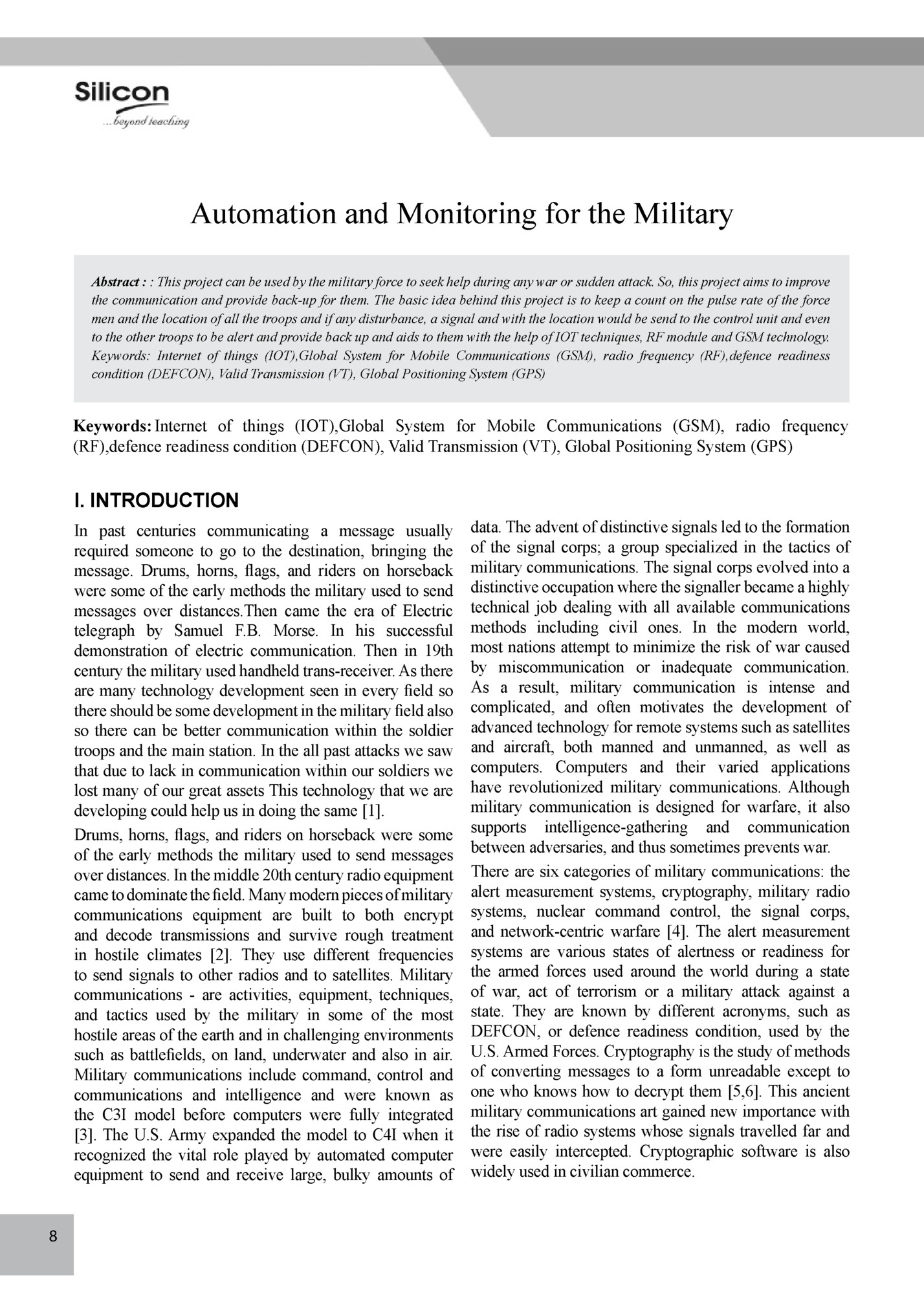
The whole project that is done can be divided into mainly 2 parts: Main and Base station 1. Main station : Fig. 1 shows the main station. Fig. 1 shows the main station. 2. Base station: Fig. 2 shows the base station Fig. 2 Base station II. POWER SUPPLY The microcontroller and other devices get power supply from AC to Dc adapter through 7805, 5 volts regulator. The adapter output voltage will be 12V DC non-regulated [7]. The 7805/7812 voltage regulators are used to convert 12 V to 5V/12V DC. Fig. 3 shows the power supply circuit. A. Regulated Power Supply A power supply containing means of maintaining essentially constant output voltage or output current under changing load conditions. B. Bridge Rectifier A bridge rectifier can be made using four individual diodes, but it is also available in special packages containing the four diodes required. It is called a full wave rectifier because it uses the entire AC wave (both positive and negative section). 1.4 volt is used up in the bridge rectifier because each diode uses 0.7 volt when conducting and there are always two diode conducting. The maximum current they can pass rates bridge rectifiers and the maximum reverse voltage they can withstand (this must be at least three times the supply RMS voltage so the rectifier can withstand the peak voltages. C. Smoothing Smoothing is performed by a large value electrolyte capacitor connected across the DC supply to act as a reservoir, supplying current to the output when the varying dc voltage from the rectifier is falling. The diagram shows the unsmoothed varying dc and the smoothed DC [8,9]. The capacitor charges quickly near the peak of the varying DC, and then discharges as it supplies current to the output. D. Regulator Voltage regulator IC shown in fig. 4 available with fixed (typically 5, 12, and 15 volts) or variable output voltages. The maximum current they can pass also rates them. Negative voltage regulators are available, mainly for use in dual supplies. Most regulators include some automatic protection from excessive current and overheating. Fig. 4 Regulator Fig. 3 Power Supply Circuit III.MICRO-CONTROLLER The AT89C51 is a low-power, high-performance CMOS 8-bit microcontroller with 8K bytes of insystem programmable Flash memory. The device is manufactured using Atmel’s high-density non-volatile memory technology and is compatible with the industrystandard 80C51 instruction set and pin out. The on-chip Flash allows the program memory to be reprogrammed in-system or by a conventional non-volatile memory 9
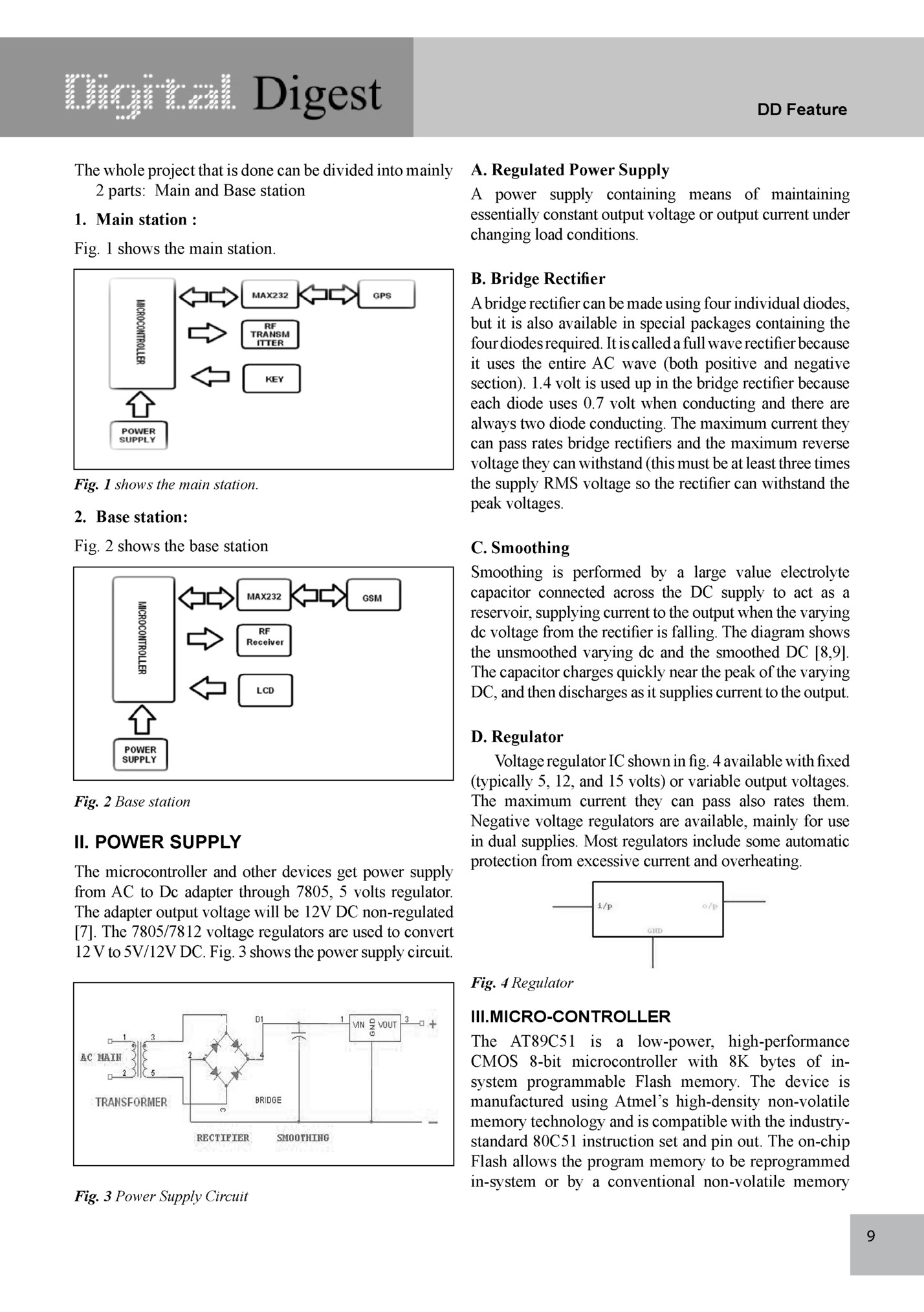
Fleepit Digital © 2021